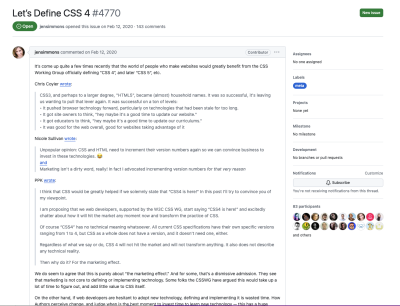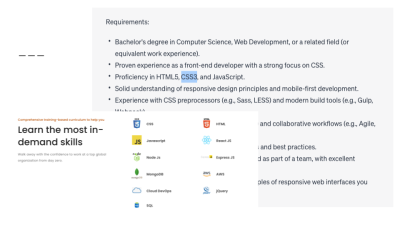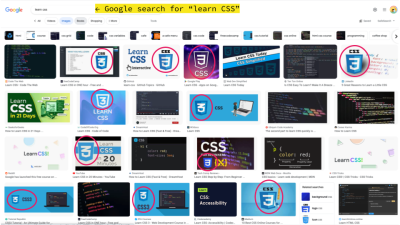- 12 min read
- CSS,
Coding,
Suggestions,
Form
We absorb been talking about CSS3 for a extremely very prolonged time. Name me a fossil, but I silent be mindful the current border-radius property feeling adore basically the most not likely CSS3 characteristic. We absorb moved on since we purchased border-radius and a slew of current aspects dropped in a single CSS3 unencumber help in 2009.
CSS, too, has moved on as a language, and but “CSS3” is silent in our lexicon because the last observe “first rate” semantically-versioned unencumber of the CSS language.
We look CSS Working Community (CSSWG) discussions going on within the birth. We absorb the draft specs and an archive of variations at our disposal. The sources are there! Nonetheless the invent-ship-implement circulation stays elusive and leaves many of us developers questioning: When is the next CSS unencumber, and what’s in it?
That is a no longer easy balancing act. We absorb spec authors, code authors, and person agents working each interdependently and independently and the conversation gaps are a mountainous option of and wide. The cease outcome? Recent aspects take hang of longer to be implemented, resulting in developers taking longer to adopt them. Shall we even defend in mind CSS3 to be the last observe astronomical big “marketing” push for CSS as a language.
That’s what the CSS-Next community is grappling with at this very moment. Whenever you haven’t heard of the group, you’re no longer by myself, but either scheme, it’s excessive time we clarify it and the guidelines coming from it. As any individual participating within the group, I assumed I would half the conversations we’re having and one of many top ways we’re impending the fashion CSS releases are communicated.
Sooner than we formally “meet” the CSS-Next group, it’s rate sparkling that it’s silent officially normally known because the CSS4 Community Community as a ways because the W3C is concerned.
And that can be the very first ingredient you have to learn about CSS-Next: it’s half of the W3C and includes CSSWG members, developers, designers, person agents, and, with out a doubt, somebody fervent in regards to the accumulate and who needs to grab half within the discussion. W3C groups adore CSS-Next are birth to all individuals to ship our disparate groups collectively, opening opportunities to form the next day’s imaginative and prescient of the accumulate.
CSS-Next, in particular, is where folk receive to talk in regards to the possibility of raising awareness of CSS evolutions at some stage within the last observe decade. At its core, the group is discussing approaches for bundling CSS aspects that absorb shipped since CSS3 used to be launched in 2009 and name the bundle (or bundles, presumably) so we have a scheme of referring to this particular “era” of CSS and pushing these aspects forward.
Why We Need A Community Care for CSS-Next
Let’s scramble help a pair of years. Extra particularly, let’s return to the 365 days 2020.
It all started when Safari Evangelist Jen Simmons posted an birth subject within the CSSWG’s GitHub repo for CSS draft specs soliciting for a definition for a “CSS4” unencumber.

This would possibly perchance be one of many last observe responses — if no longer the greatest response — to a CSSWG subject essentially based mostly mostly entirely on emoji reactions.

The opinion that of defining CSS4 had some help-americaby Chris Coyier, Nicole Sullivan, and PPK. The opinion that is to push applied sciences forward and help educators and space house owners, even though it’s precise for the sake of promoting.
Nonetheless why is that this crucial? Why have to we care about another diploma or “CSS Saga”? To accumulate to that level, shall we must chat about CSS3 and what precisely it defines.
What Precisely Is “CSS3”?
The CSS3 grouping of aspects integrated diploma-3 specs for aspects from typography to selectors and backgrounds. From this level on, each CSS spec has been numbered in my notion.
Nonetheless, CSS3 is silent basically the most standard term developers utilize to convey the capabilities of most modern CSS. We look this at some stage within the accumulate, from the fashion academic institutions suppose CSS to the job requirements on resumes.
The term CSS3 loses which implies 365 days-over-365 days. You would possibly perchance look the dilution everywhere. The earliest CSS3 drafts absorb been printed in June 1999 — sooner than many of my colleagues absorb been even born — and but CSS is one of many quickest-rising languages within the current webscape.
What About The CSS3 Stamp?
As soon as we peek at job postings, we trot into vacancies soliciting for knowledge of CSS3, which is over 10 years extinct. With out an updated diploma, we’re precise asking when you happen to’ve written CSS for the reason that border-radius property came out. Furthermore, after we are looking to learn CSS, a CSS3 logo next to academic materials now no longer signals current subject cloth. It more or less feels adore time has stood silent.
Here’s an example job posting that illustrates the subject:

Nonetheless that’s no longer all. Whenever you function a Google search on “Be taught CSS” and check the photos, you can be surprised how many CSS3 logos you would possibly perchance be in a position to set:

About 50% of the photos insist the CSS3 badge. To me, this clearly signals:
- Of us need badges or logos to reduction in signaling skills.
- The CSS3 put has made a mountainous influence on the accumulate ecosystem.
- The CSS3 logo has reached the cease of its efficacy.
CSS3 had silent has a mammoth influence on the ecosystem. The same logo is attempting to sigh it teaches Flexbox all the fashion to color-mix() — a unfold of many of of CSS aspects.
What Precisely Does “Standard CSS” Imply?
CSS3 and HTML5 absorb been big enhancements to these respective languages — we’ve attain a prolonged scheme since then. We absorb aspects that folks didn’t even reflect absorb been that you just’ll absorb the potential to mirror of help in 2012 (after we officially spoke of CSS3 as a diploma).
Let’s tell, there used to be a time when folk notion that containers didn’t know the leisure and it in no blueprint be that you just’ll absorb the potential to mirror of to fashion an ingredient in accordance with the width of its dad or mum. Nonetheless now, useless to sigh, we have CSS Container Queries, and all of this is that you just’ll absorb the potential to mirror of at the present time. The things that are that you just’ll absorb the potential to mirror of with CSS modified over time, as so beautifully suggested by Miriam Suzanne at CSS Day 2023.
We inventory out no longer are looking to ignore the success of CSS3 and tell it’s disagreeable; truly, we deem it’s time to repeat the astronomical success of CSS3.
Remember yourself 10 years from now reading a “up to date” CSS characteristic that used to be equipped as many as 10 years within the past. It wouldn’t add up, apt? Standard isn’t any longer a future-proof name, something that Geoff Graham opined when asking the last observe quiz, “What precisely is ‘Standard CSS’?”
“Naming is continuously onerous, but it’s precise something we have to reduction out in CSS to well decide out things. I reflect it’s time we launch naming [CSS releases] adore this, too. It’s entirely a subject of time sooner than “up to date” isn’t “up to date” anymore.”
— Geoff Graham
That is precisely where the CSS-Next community group comes in.
Let’s Talk About “CSS Eras”
The CSS-Next community group targets to align and modernize the standard understanding of CSS within the wider developer community by labeling characteristic sets that absorb shipped for the reason that initial arrangement of CSS3 aspects, serving to developers upskill their understanding of CSS at some stage within the ecosystem.
Why Isn’t This Section Of The Net Platform Baseline?
The definition of what is “current” CSS adjustments with time. In most cases, specs are incomplete or haven’t even been drafted. Whereas Baseline appears at the current browser help of a characteristic in CSS, we are looking to grab a stare upon the evolution of the language itself. The CSS phases have to not ever care about which browser implemented it first.
It’ll be more nuanced than this truly, but that’s fairly unheard of the gist. We also don’t need it to change into another “up to date CSS” bucket. Indeed, referring to CSS3 as an “era” has helped compartmentalize how we can shift into CSS4, CSS5, and former. Let’s tell, labeling something as a “CSS4” characteristic provides a slightly as a ways as when that characteristic used to be born. A characteristic that reaches “baseline” meanwhile merely signifies the arrangement of that characteristic’s browser implementation, which is a separate subject.
Figuring out aspects by era and implementation arrangement are each indicators and offer meta recordsdata a pair of CSS characteristic but with assorted functions.
Why Not Work With An Annual Snapshot As a replace Of A Numbered Generation?
It’s heavenly to shock if a likely solution is to grab a “snapshot” of the CSS characteristic arrangement every 365 days and utilize that as a mile marker for CSS characteristic releases. Nonetheless, an annual characterize of the language is less efficient than defining a particular era in which particular aspects are equipped.
There absorb been a handful of years when CSS used to be slightly silent when put next with the mad escape of the old few years. Remember a 365 days in which nothing, or presumably entirely a pair of, CSS aspects are shipped, and the snapshot for that 365 days is kind of an identical to the old 365 days’s snapshot. Now imagine CSS explodes the next 365 days with a deluge of current aspects that outcome in a huge delta between snapshots. It takes psychological agility to compare whole snapshots of the whole language and accumulate what’s current.
Targets And Non-Targets
I reflect I’ve effectively established that the term “CSS” by myself isn’t sure or in actual fact helpful ample to illustrate the evolution of the CSS, precise as calling a clear characteristic “up to date” degrades over time.
All of this comes help to a arrangement of targets that the CSS-Next group is rallying around:
- Lend a hand developers learn CSS.
- Lend a hand educators suppose CSS.
- Lend a hand employers convey up to date web skills.
- Lend a hand the community realize the progression of CSS capabilities over time.
- Invent a shared vernacular for describing how CSS evolves.
What we offer out no longer need is to:
- Impression spec definitions.
CSS-Next isn’t any longer a group that can convey the working course of of or influence working groups such because the CSSWG. - Invent first rate developer documentation.
Making something adore a brand current model of MDN doesn’t accumulate us closer to a wiser understanding of how the language adjustments between eras. - Define browser specification work.
This ought to be performed in linked standardization or pre-standardization boards (such because the CSSWG or OpenUI). - Educate developers on CSS simplest practices.
That has a ways more to reduction out with characteristic implementations than the aspects themselves. - Arrange browser compatibility recordsdata.
Baseline is already doing that, and besides, we’ve already established that characteristic specs and implementations are separate concerns.
This doesn’t mean that all the things within the last observe list is null and void. We would possibly perchance, as an illustration, absorb CSS eras that list all the aspects specced in that duration. And interior that list, there would possibly perchance be continuously a baseline reference for the implementations of these aspects, making it more uncomplicated to ship forward some strategies for the next Interop, which informs Baseline.
This leaves the CSS-Next group with a wisely-organized-sure focal level to:
- Be taught the community’s understanding of most modern CSS,
- Construct a shared understanding of CSS characteristic evolution since CSS3,
- Grouping these aspects into with out inform-digestible phases (i.e., CSS4, CSS5, and so forth), and
- Educate the community about up to date CSS aspects.
We’d Seemingly Open With The “CSS5” Generation
Loads of notion and work has gone into the fashion CSS is described in eras. The initial opinion used to be to receive where CSS3 left off and soar straight into CSS4. Nonetheless the option of aspects launched between the 2 eras would be huge, although we narrowed it all the fashion down to precise the aspects launched since 2020, in no blueprint mind 2009.
It is intelligent, as an replacement, to separate the adaptation and refer to CSS4 a performed deal as of, tell, 2018 and a prime half of CSS in its current disclose as we launch with the next logical duration: CSS5.
Here’s how the definitions are currently defined:
CSS3 (~2009-2012):
Stage 3 CSS specs as defined by the CSSWG. (immutable)
CSS4 (~2013-2018):
Well-known aspects that weren’t half of CSS3 but are already a prime half of CSS.
CSS5 (~2019-2024):
More moderen aspects whose adoption is step by step rising.
CSS6 (~2025+):
Early-stage aspects that are deliberate for future CSS.
Uncle Sam CSS Desires You!
We launched a quiz for comments ultimate Could for community input from developers equivalent to you. We’ve got a pair of comments which absorb been taken into legend, but we would like a ways more strategies to reduction present our come.
We wish a huge advisor response from the community! Nonetheless that takes awareness, and we’d like you to build that happen. The leisure you would possibly perchance be in a position to function to let your groups and colleagues that the CSS-Next group is a ingredient and that we’re attempting to resolve the fashion we talk about CSS aspects is drastically liked. We are looking to know what you and others take into legend the things we’re wrestling with, adore whether or no longer or no longer the fashion we’re grouping eras above is a sound come, where you reflect these lines ought to be drawn, and when you happen to agree that we’re aiming for the apt targets.
We also need you to grab half. Anyone is welcome to be half of the CSS-Next group and we’d undoubtedly utilize help brainstorming strategies. There’s even an incubation group that conducts a biweekly hour-prolonged session that takes disclose on Mondays at 8:00 a.m. Pacific Time (2:00 p.m. GMT).
On an extraordinarily interior most demonstrate, I’d adore so that you just would possibly perchance add that I joined the CSS-Next group purely out of curiosity but grew to change into a ways more actively eager once the mission grew to change into very sure to me. As a developer working in an company, I look how lickety-split CSS adjustments and absorb struggled, adore many of you, to defend.
A seasoned colleague of mine commented the assorted day that they wouldn’t even know come vanilla CSS on a current web space venture. There is no disgrace in that! I know many of us feel the an identical scheme. So, why no longer ship it to marketing terms and resolve out a wiser scheme to frame discussions about CSS aspects in accordance with eras? You would possibly perchance help accumulate us there!
And when you happen to mirror I’m harmless in terms of talking about CSS in generic “up to date” terms, all it takes is a transient peek at the headline of another 4nds article I authored… this 365 days!
Let’s accumulate going with CSS5 and unfold the observe! Let me hear your strategies.
Sources
- CSS-Next Community Homepage
- CSSWG Drafts Command #4770: Let’s Define CSS 4
- CSS-Next Command #92: Preliminary CSS Stage Categorization
(gg, yk)






